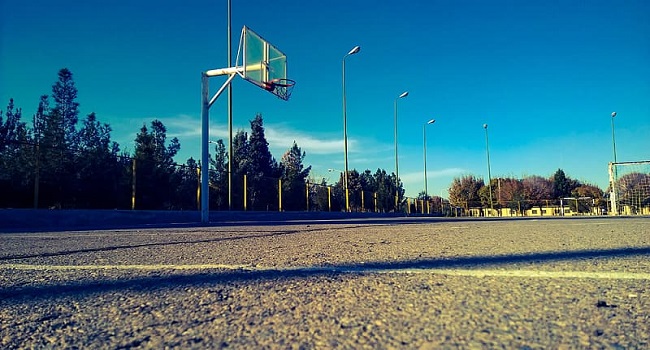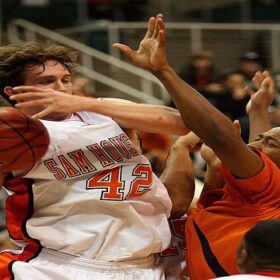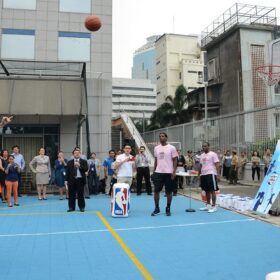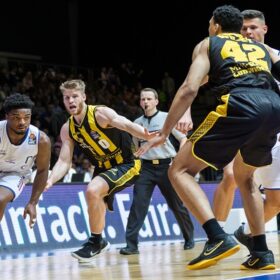We bet you must be thinking about how two teams travel to a place far away and then play basketball somewhere in a deep trench valley. And perhaps, traveling in basketball outlines all their activities and exercise they perform during their road-trip. Sorry to burst your bubble, but this isn’t correct.
Unlike the actual traveling to fascinating places, you wouldn’t like traveling in basketball if you or your team player has been charged for it. You must be familiar with this term if you are a basketball fanatic. You must have seen how the referee blows the whistle and calls a player for traveling.
It might seldom appear for NBA, as some people claim that it doesn’t strictly implement it, but it is imposed sternly in the lower levels. Players in youth leagues are held accountable for this violation as they are being trained to refrain this at all costs when they promote to higher and professional level basketball.
Traveling in basketball is a considerable violation in basketball that occurs when a player, who has the ball, just holds it, doesn’t dribble it, but makes a move with his feet that is against the rule. Because of this violation, the possession of the ball is granted to the opposing team (turnover).
It may seem quite simple to you, but imagine how you can make an illegal move with your feet? Many questions would pop in your head, so let’s explore the answer to each.
Facts About Traveling In Basketball
You can easily get confused while identifying which circumstance calls for a violation and which doesn’t. There is a very thing difference between the two. Due to a considerable variation in the rules of different leagues, different moves qualify for a violation. They might be synonymous but not actually identical in all leagues. But there are few instances where traveling is considered as a violation in all leagues like:
- If a player can only commit traveling in basketball if he is not out of bounds
- A player cannot be called for traveling if he is dribbling the ball
- Only the player who has the ball can travel
- In most cases of traveling, the illegal move from the pivot foot is present. In the next section, we will see what a pivot is.
Pivot Foot
So, what is this pivot foot that we have been talking about, and how does it relate to traveling in basketball?
Pivot can be any foot (left or right), but the ball must be in contact with floor league of the court. Imagine when the traveling occurs your foot is on the floor . It may be a precise call, as it is hard to track the position of the foot. A player can spin even only if the pivot foot is on that exact spot and doesn’t deviate from there.
So, the player can only commit this violation if his pivot floor remains on the exact same spot and is in possession of the ball. But he must not be dribbling, passing the ball to another player, or shooting it towards the hoop. Therefore, a pivot foot must happen so that a player can be called for traveling in basketball.
This foot is only established if the player remains stagnant (doesn’t dribble or perform any other action). If that foot moves away from that spot of the contact between floor and foot disconnects, and the other foot lands on the floor, that will now be considered as the pivot foot.
However, if the player initially lands on one foot, that will be a pivot foot.
There is an exceptional case where there is no pivot foot. It usually occurs after a “jump stop”. A jump stop refers to the situation when a player catches a ball while he is moving, then anchors his one foot on the floor and then jumps up in the air and then lands on both feet. This description may not be vivid enough to help you follow the whole scenario. You can watch a video to get a more lucid idea of this occurrence. But in this case, there is no pivot foot, and the player cannot move either of his feet.
The whole concept of traveling in basketball is on the establishment of a player’s pivot foot. The rules pertaining to the pivot foot may vary from match to match, so you can learn about the rules here.
Illegal Movements That Cause Traveling
What constitutes an illegal movement that contributes to the emergence of traveling in basketball violation? In many different situations, a player may move his feet in a plethora of ways, so which moves qualify as illegal. Let’s see:
- If a player begins to roll on the floor after sliding and he maintains the possession of the ball
- Moving the from the spot or sliding across the floor after a pivot foot the same spot or floor before either shooting or passing it to another player
- Falling on the floor without maintaining contact with the floor or establishing a pivot foot
- Lifting the established it on the floor to start dribbling
- Sliding either of the side is established or available
- Jumping from the floor and disconnecting the contact of and landing on either foot
Common Examples Of Traveling In Basketball?
Traveling in basketball is more common than you can imagine. You won’t hear about is as much or would see players being charged with it too often because to call this violation, an insane amount of meticulous observation and precision would be required. Also, the professional players have trained themselves well to abstain from committing this violation.
This violation is a lot more intricate than spotting a player take his foot off of the ground. So, let’s see how common this violation is
Pivot Slide
A traveling in basketball is when the foot is in constant move from the exact spot.
Early Step
In the momentum of the game, the player takes a step and lifts his pivot foot above before he has released the ball to dribble. This happens so frequently, this commonly occurs when a player aims to shoot, and he moves towards the basket from a stationary position.
Three-Points Step
And there he decides to shoot without dribbling the ball. In this scenario, the player lifts his pivot foot and so it is a traveling violation.
Up and Down
A player may raise himself by jumping off of the floor with the intention to wither pass the ball to another player or shoot it directly towards the hoop, but he is unable to release the ball, and he lands back on his feet. This also falls under the category of a traveling violation.
Rebound Shuffle
In the heat of the game, a player gets a rebound, and he then shuffles his feet or switches them off the floor and then lands on the floor; this is a traveling violation.
Rebound refers to the opportunity when a player shoots the ball but misses it, and the ball hits the board or the basket and falls back in the hands of any other player.
How To Avoid Traveling In Basketball?
The traveling violation penalty is the loss of possession of the ball, which may turn the table of the game. So, to avoid it, players have to work really hard on their performance and gameplay.
As a beginner, make sure you constantly check your dribble and watch your moves under a microscope. Monitor the moves of your feet and establish a pivot foot at the beginning. Make your coach go extra tough on you and call you every time you commit this infraction.
Practice your ball handling techniques again and again and play under control. Make sure you have full control over your feet and especially your pivot foot. Mark the spot you are to keep it on. Play under strictly controlled situations and play fast. A restricted time limit will push you towards having a stronger grip over your techniques and strategies.
Conclusion
It may seem impossible to play basketball and not commit a traveling violation; so many rules and clauses you ave to take care of and understand in order to avoid this. So, make sure you get a good grip over this concept earlier in your time of learning the basics of basketball. And practice avoiding it, again and again, until you are a pro at it.
Many critics do believe that the NBA lets players in basketball because it tends to occur frequently but is rarely called upon. This may be a fallacy because the wit and proficiency of basketball players cannot be questioned so easily. They are smart and sensible and so swift. Any move may seem like an infringement, but trust us when we say basketball players know what they are doing!





